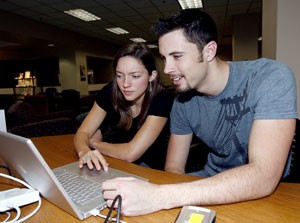For some, cancer is a death sentence.
For Daniel Shapiro, it was an inspiration.
Motivated by his fight with the aggressive disease over a decade ago, the associate professor of clinical psychiatry sought a way to bring the human side of medicine to UA medical students.
The College of Medicine Video Slam project was born.
In direct contrast to usual medical training, the project allows groups of second-year students to film their patients in order to tell the personal side of an illness or hospital stay, Shapiro said.
“”The in-patient and out-patient work is typically brief,”” he said. “”This is what physician training is lacking.””
After filming their patients for about six months, the two-to-three-person groups must condense their footage, usually several hours worth, into a short seven-minute film.
Such arduous editing requirements are necessary because they require students to spend time looking over their footage, said Steven Pike, a second-year medical student and current participant.
“”The editing process is really difficult,”” he said. “”Everything the patient says is gold, so it’s tricky to get all the right elements.””
Filming is tricky because of the balancing act needed in the process. If too much footage is filmed, students can feel overwhelmed. If too little footage is taken, students may not have captured enough valuable material, said Serena Jain, a second-year medical student and current participant.
After the final films were submitted in the program’s pilot year, 2006, more than 80 doctors, nurses and medical students crammed into a conference room to watch the footage, Shapiro said.
“”This was my first hint that the project might be more popular than I realized,”” he said.
The films were also shown to other second-year medical students at the college in the fall.
The Video Slam project has become a successful and popular program in a short amount of time. When Shapiro started the project in 2006, it included eight students.
Due to its burgeoning reputation, the program now has 22 students, he said.
The project’s success is even more surprising when taking into account its status as an extra-curricular activity – it is not part of the college’s academic curriculum, he said.
“”There is no incentive,”” Shapiro said. “”The students are there because they want to be.””
As opposed to other programs and classes, Video Slam allows students to gain first-hand experience dealing with the personal side of patient care in a fun and unusual way, Pike said.
“”I thought it would make me a better doctor,”” he said. “”We don’t get to see a lot of the human side.””
While the program teaches students the delicate side of the medical profession, it is also meant to prepare students to care for chronically ill patients, Shapiro said.
As most medical training focuses on illnesses that do not last very long, modern medical students feel intimidated in caring for chronically ill patients, he said.
The project helps these students feel more equipped to deal with patients suffering from conditions and diseases such as Parkinson’s disease, muscular dystrophy, leukemia, AIDS and cancer, he said.
“”It’s important not only for (students), but also for the families we’re working with,”” Jain said. “”It’s an experience we don’t get in the classroom.””
The project’s influence now spreads far beyond the halls of the College of Medicine. After Video Slam films were shown at a national conference on chronic illnesses, other schools across the country began to express interest, Shapiro said.
The films are now being shown and used at the University of Miami, Southern Illinois University and the Thomas Jefferson Medical College in Philadelphia.
Southern Illinois has even taken up the task of creating its own Video Slam projects next year, Shapiro said.
The program’s expansion shows that the medical industry is ready to advance the care for patients’ experiences in medical centers, as the idea that began in a hospital bed over a decade ago now reaches out to a nation, Shapiro said.
“”It is extremely gratifying to know that in some small way, I might be assisting future patients to have better experiences with their physicians than I had during parts of my cancer experience,”” he said.









